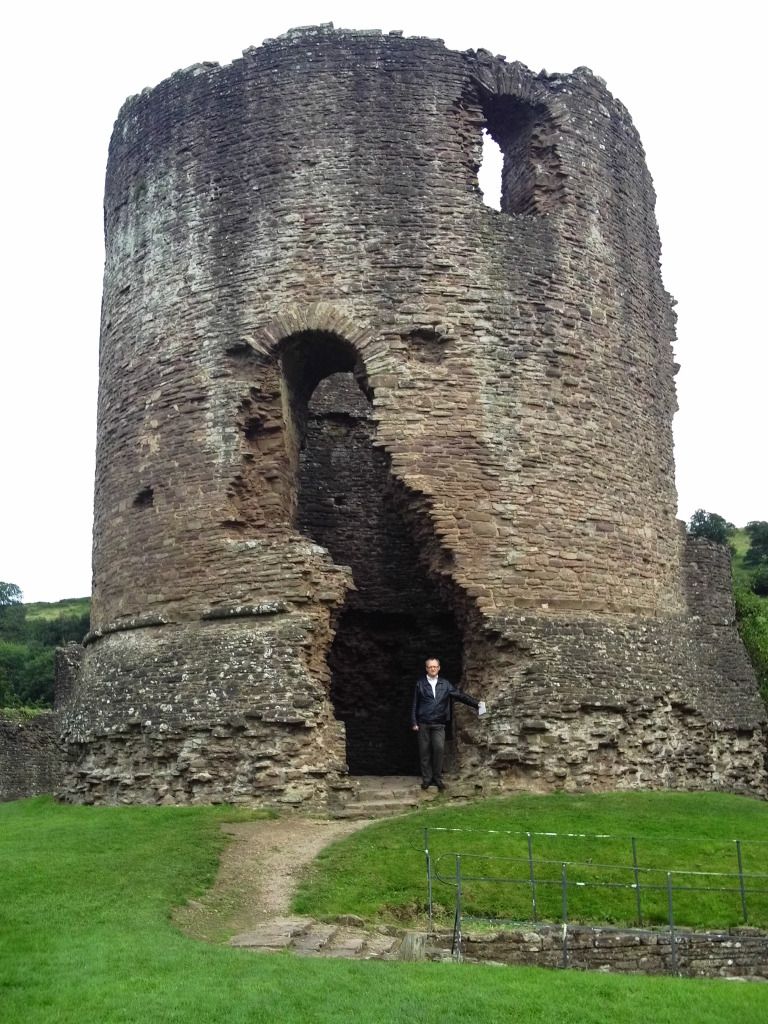This, I'm very glad to say, is the
completed model of the Great Round Tower based on the castle at Skenfrith. With expended delays it actually took just over a year to finish. In real
terms it probably took about a two weeks to build but there were several times when
this model was very nearly consigned to terrain heaven when I was sorely
tempted to launch it into the nearby park via my size ten boot.
Its torturous development can be followed
by viewing these previous posts (click on the links for a blow by blow account).
The reason I decided not the fix the
hourdings or the entrance stairway in place is a simple one. Travelling through northern France you
will often see medieval castles in a decent state of repair, for
instance the keep at Falaise which was shelled by the Allies during for WWII. It occurred to me
that by making the woodwork removable the piece could then be used on the tabletop for
a setting anywhere in between the 13th to the 21st century.
 |
| Hourding painting detail |
If I thought the hourdings was complex, attempting the stairway and entrance was a different league. The model sat, ignored, for several months on my desk. At one stage I even moved it out of sight to avoid it causing me further annoyance. It was a trip to south Wales to see the original inspiration, Skenfrith and other nearby castles, that finally goaded me into finishing this project. Seeing illustrations and reconstructions give me a better idea of how to attempt this final part of the model, but this was still a very much a hit and miss affair. Several abortive attempts were made using bamboo barbecue skewers and Blu Tack to make a crude form of prototype. Sorry no WIP photographs as I was too busy grinding my teeth in frustration, uttering foul oaths and yelling various other forms of industrial phrases at the model.
 |
| Internal view of the stairway |
 |
| External view of stairway |
 |
| Detail of small gatehouse |
Using the skewers enabled me to work out the heights of the various vertical posts without wasting strips of hardwood or balsa. I won't attempt to describe how I made the stair treads fit as, to be perfectly honest looking back I'm not entirely sure how I achieved it myself and I'd have to admit it was through more luck than judgment that it worked.
The structure is held together with copious amount of PVA glue and threats of violence.
 |
| Detail of roof including mini shampoo bottle/chimney |
 |
| The Welsh original - with brother for scale. |
Note the particular features of this style of castle:
- First floor entry above a battered base
marked by an offset spiral stair to the upper floor,
- Roll mouldings at the external batter,
- Semi-circular projecting turret (on the far right of the tower).
 |
| The model with 28mm figures for scale |
For quite a while I pondered about the final colour schemes for of the model. The now familiar site of timber frame buildings painted harsh contrast of black and white is largely a Victorian invention. But relocated/reconstructed medieval buildings such as ones that can be seen at the Welsh National History Museum at St Fagan's proved to be helpful reference and yes, a number of the building are indeed painted bright white as a result of whitewashing. another is painted bright red, the colour was thought to be help scare away evil spirits. In the English county of Suffolk houses are still painted pink (the colour known appropriately enough as Suffolk Pink) thought to have been originally achieved by mixing ox blood or the juice of sloe berries into the plaster.
However the bleedin' obvious occurred to me. The name of the neighbouring Llantillois Castle, known in English as White Castle, was the give away. The castle had obviously been plastered and covered in whitewash, therefore I decided to take the easy way out and paint this model white as well.
Now though the question of painting a model so this size white without it appearing to look like an extra large toilet roll (or a kitchen roll - if you're posh) caused me to pause and consider my options. With these model I used test pots of paint from B&Q (a large UK D.I.Y store) as there is rather a lot of surface to cover.
Shading and weathering adds considerably to any model but you obviously can't highlight white with a lighter colour. Therefore I had to find a suitable off-white paint to cover the entire surface of the building which would enable me to finish off with a drybrush using a plain white paint to pick out the surface detail. The entire model was given a brush over with a very diluted wash of various shades of brown and sepia coloured inks.
Well its certainly been a journey (that awful phrase Z-list celebs say on the telly whenever they've been in a show, paid a lot of money not to do much and manage to lose their dignity all at the same time, 'I've been on such a wonderful journey.') but I doubt I'll ever undertake anything similar to this for a good while.















